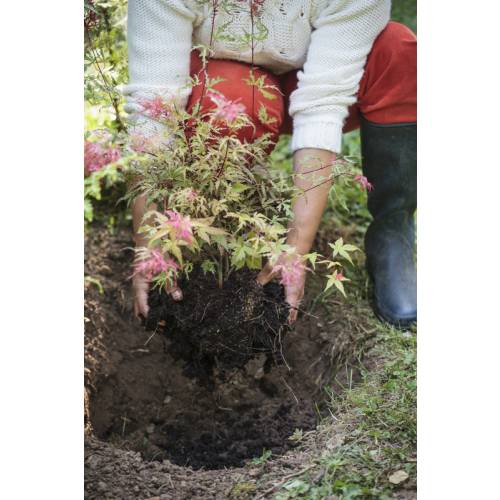
Each plant has its needs
The Japanese Maples
- Details
-
Tall or small, they all have in common the ability to be easy to grow. Moreover, they are not fragile: Do not go without them, especially grown in pots!
An incredible diversity
Japanese Maples are diversified. The classical shaped specimens have palmed-leaves which take on beautiful autumnal shades. Others have rounded leaves or on the contrary indented leaves. They are variegated with all the possible combinations. In the spring, their blossoming is pretty. And during summer, their foliage takes on tints going from green to a nearly black- purple, becoming golden-yellow in between. Apparently there is about half a thousand varieties of Japanese Maples. There is bound to be one for you!
It withstands everything, or nearly everything.
Some imagine than Japanese Maples are heath-peat lovers. In fact they withstand well calcareous and clayish soils as long as some compost is added to it. Varieties which have purple or green leaves and which have not highly indented foliage withstand sun and there is no need to place them in a shady spot. For all these varieties, a partially-shaded site, which benefits from sunshine part of the day, is ideal. In its natural habitat, the Japanese Maple is a tree which grows on borders, shaded by larger trees. Some varieties can become quite tall (more than 6m in height) while others will only grow as a bush.
Everywhere, except on a wind-exposed site
The Japanese Maple can be grown either in pots or in the ground, in smaller gardens as well as large ones. Its sole enemy is not the cold but the wind, which dries it in summer and makes it suffer in winter. In windy areas, think about growing it behind a hedge of evergreen shrubs.
Planting a Japanese Maple is not difficult. Choose carefully the site in which to grow it, according to its colour, in particular its foliage. So, seasonal yellow leaves are sensitive to the sun while redder varieties need more light than the others.
A Japanese Maple can withstand a slightly dry soil in summer if it can grow its roots deeply into the ground. In a rocky soil (especially calcareous) it is best to grow it in a pot unless the area benefits from wet summers. Elsewhere, it only needs to be watered during the first years following plantation so that it settles well and to provide it with mulch from May to October. Use the amount of one watering can each week.
Planting steps by steps
1 Soak the earth ball in a bucket.
2 Remove it from the pot.
3 Ensure that the prepared hole is large enough and deep enough.
4 Place it at the right height.
5 Fill the hole with compost if the soil is poor.
6 Water around the roots.
And pruning ?
It is only necessary if the Japanese Maple takes up too much space in the smallest gardens, or to give it a particular shape. It is indeed possible to sculpt it as it withstands well pruning. The sole imperative: prune it in February-March just before its starts to grow again. A Japanese Maple can live longer than a century, even the smallest varieties. You will be able to enjoy it for a very long time! - Photos (8)








